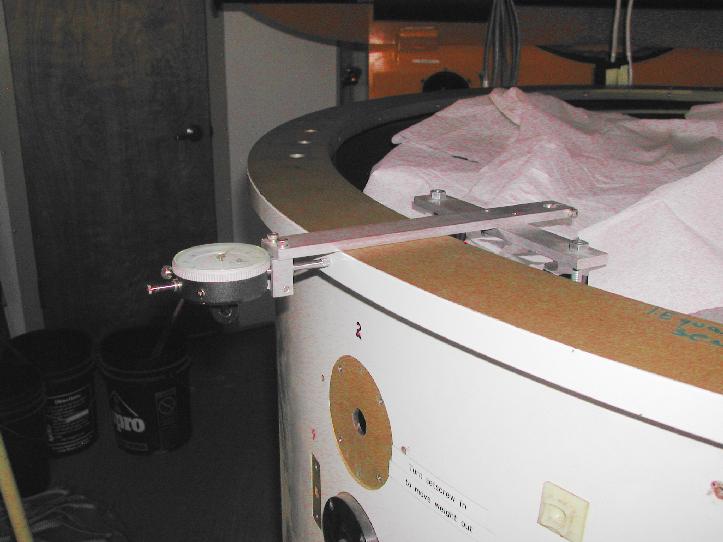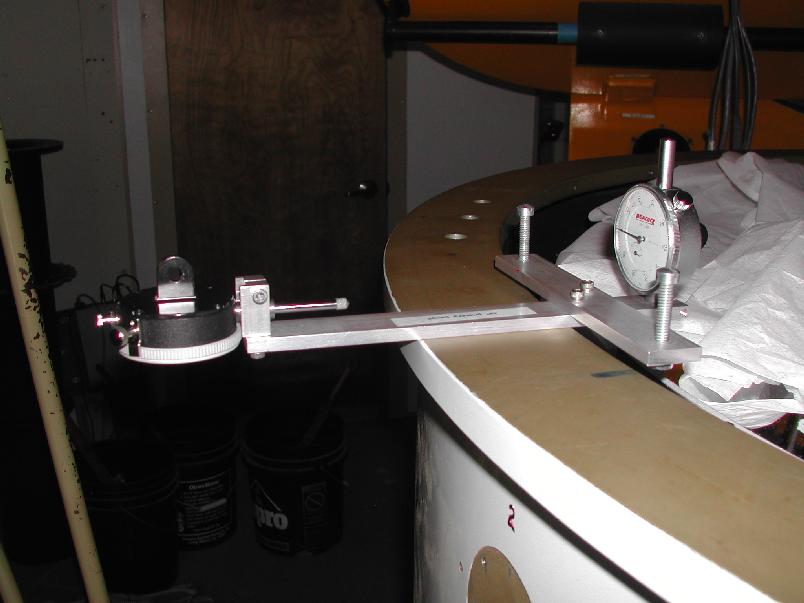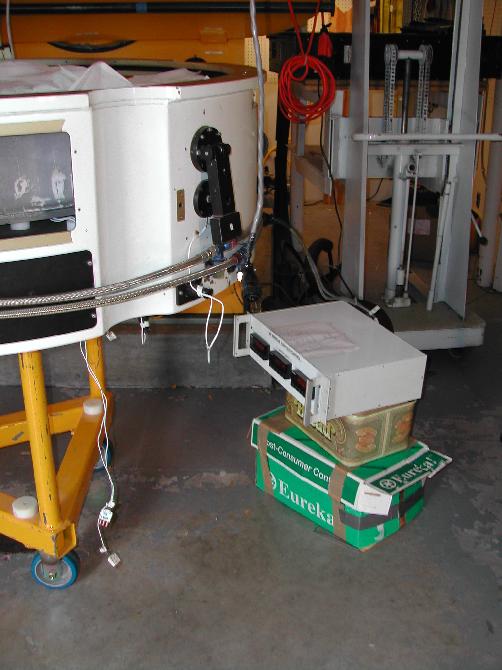FLWO 48" INCH TELESCOPE REALUMINIZING PROCEDURE
Updated 08/23/13 EF
Items needed:
Notify SO and confirm that schedule is OK.
Sign Agreement and forward to SO.
Issue PO for the work.
Aluminum mirror lifting device
Yellow bar
Yellow hoisting tool
Yellow milk stool
Mirror box and lid
Plastic tarps to cover mirror box and cell in case of rain
Foam mirror cover
Crown forklift
Pallet jack
2 short lifting straps
Mechanical Hoist
Removal Procedures
-
Remove Dec primary bearing cover (East fork).
-
Move telescope in DEC only, South to ~0 DEC so that access to the
Eastern cell bolts (particularly the southernmost of the three) can be
had. Loosen the two bolts. This is done because these bolts can't be
fully accessed when telescope is at zenith. Don't even try.
Even more complicated if the topbox has been removed.
On 07/25/12,
we had the topbox off after the rain event on Sunday 07/15/12
(see Changelog). Ted managed to remove the middle bolt with the
telescope pinned. We managed to slowly and
carefully move the telescope after
removing the DEC pin using ropes and pulleys tied to the
OSS on the N and S with Wayne, Ted and
Emilio handling the ropes. The remaining problem bolt on the N end
of the trio finally became accessible and was removed.
-
Return telescope to zenith.
-
Pin telescope at zenith.
-
Bring secondary mirror all the way toward primary (larger numbers
for the hexapod) with the telescope control program. From code
or hexapod PC:
Range -24 to +24 mm, so move to 23.0
-
*OPTIONAL* If filter wheel assembly requires work: remove all filters
from top box, using TCS.
-
*OPTIONAL* If filter wheel assembly requires work: move all guide
probe motors to 0 using TCS, then disconnect motor power.
-
Remove instrument and cabling. Disconnect cabling to top box.
-
Remove North electronics mounting plate.
-
While standing on closed mirror doors, remove secondary baffle, 4
3/32" Phillips screws.
-
Remove secondary mirror. First, remove felt on center of secondary.
Second, insert all-thread safety bar through the center of the support
and secure it with the nut (which should be on the bar when in
storage) below the secondary. Third, remove the 4 allen screws
(3/16") that hold
the mirror mushroom against the hexapod; the mirror is held by the bar at
that point. Fourth, one person should hold the mirror by the collar
while the other loosens the nut on the bar, and then carefully lower
it and hand it to a third person at the top of the yellow ladder.
-
After the secondary is moved to the hole in the center of the wooden
(dewar) cart with the mirror facing up, remove secondary mirror mount
by removing the 6 allen screws that hold the washers (spring and
teflon) on at the front. From below the hole, remove the 3 allen
screws (9/64") that tie the holding fixture to the metal puck on the
back of the mirror. Then, gently twist the "mushroom" with respect to
the mount until it is twisted off. It can take some doing as it's a VERY
snug fit.
-
Place secondary mirror in box for shipping (replacing the second
secondary mirror, which should be stored in a secure location).
-
Remove top box assembly. Raise the lifting table to the level of the top
box, and then remove the bolts that hold the spacer plate onto the cell.
-
Remove the primary baffle. It has a ring where the mirror covers rest,
so it is best to do it at this point, not earlier.
-
Remove cell cover plates.
-
Deactivate 27 axial actuators (from back of cell) by screwing OUT
(9/64") allen head screws (the screw that pushes
on each puck) until counterweights are pinned to cell. The
primary will be resting on the 3 axial hard points once you've done this.
-
Install yellow bar at top ring using two short yellow
straps around the top ring.
Bar should be aligned north/south. One person should remain on top of primary
covers to work with hoist.
-
Install mechanical chain hoist.
-
Bring chain down through the Cass hole, and hook it onto the yellow
hoisting tool (flange with stem, aka mushroom).
-
Raise hoisting tool to bottom of mirror cell. Bolt tool to cell (2
bolts will do). Tighten up chain.
-
Loosen and remove cell bolts. Note that the northernmost bolt on the East
side is shorter than the others.
-
Lower cell onto the milk stool (3-legged cart), until it rests on the
legs but without engaging the legs in the holes to lift the mirror. Be
careful of cell/telescope clearances.
-
Working above the mirror, remove the earthquake/baffle ring.
-
Remove the radial dial indicators (these are all numbered, keyed to
the same numbers on the cell).
-
Remove the radial actuator connections to the radial load spreader
bar. This is delicate! The bars are epoxied to the glass and it is
possible to pry them off, we have done it too many times. The last
time was in June 2010 when we lowered the cell and lifted M1 to take
measurements with Mario Rascon of SOML. We now have a bike chain break
tool that MC donated. It should be used to pop the pins that link the
actuators to the bars, after removing the cotters at the ends of
the pins. Applying excessive lateral force caused the plates at the
ends of the bars to break off in June 2010.
As of August 2013, we have new spreader bars, with posts epoxied
to the glass at COS. They should be sturdier than the old ones, but
caution is still required!
-
Back off the radial hardpoints. (The actuator covers used to have to be removed
for this purpose but they haven't been used for a long time.)
-
Lift the cell off the milk stool a few inches, and align the legs with
the holes in cell that will permit contact with the mirror.
-
Lower the cell onto the cart, until it makes contact with the glass.
-
Slowly lower the cell until the mirror extends out of the cell by about
1.5 inches. The cell/tool should now be sitting on the cart.
-
Install the aluminum triangular mirror lifting fixture. Lift the mirror
off of the milk stool.
-
Remove the radial load spreader bars from the mirror (these
are also numbered and keyed to the same numbers on the mirror).
-
Roll the cell out of the way. Take care not to run a wheel over a trench
where the floor is weak.
-
Open the box, remove top foam padding, and use the pallet jack to roll
it under the mirror.
-
Lower the mirror into the box.
-
Remove the lifting fixture
-
Put the top on the box.
-
The mirror box is 64"x64"x 19". The 19" includes the blocks on the bottom
to provide fork lift access. The box weighs 550 pounds. The mirror weighs
330 pounds. The total weight of the box and the mirror is 885 pounds.
-
Load the mirror box in the flat bed truck. The Crown 15M hand forklift
will lift 1500 pounds at 20". There is a chance that the mirror box could
tip forward, therefore, the mirror box should be attached to the fork lift
with a harness. The height of the loading dock is 25" from the drive. Lady's
bed is 40" from the drive. The front part of the mirror box is first set
in the truck and then the mirror box is pushed in with the fork lift and
people. This works better than it sounds.
-
No special padding is required. Drive flat bed truck to Sunnyside.
Reinstallation
In general, the reverse of disassembly. The following notes should be useful.
When lifting the box from the truck and moving into the dome, be certain
that the 4x4's on the box clear the front fork wheels as well as the forks.
- Mount spreader bars on mirror before installing mirror in
cell. The old posts on the glass were not quite in the right place, thus
the bars had to be offset slightly. The S and SE bars were centered; the
N and NE bars offset 3/32 clockwise w.r.t. the cell; the NW
and SW bars are offest 3/32 counter clockwise. This no longer applies for
the new mirror.
As of August 2013, the new posts are symmetrically arranged.
They worked like a charm.
The spreader bars are mounted
to the posts with, starting at the post, a plastic washer, 2 cupped
bellevilles, bar, 2 cupped bellevilles, nut. Per DFM 08/07/13.
- Remove radial dial indicators before installation if not
out already (which they should be!).
- Get rotation correct before lowering mirror all the way into cell. Now
lower mirror onto axial hard points. RH made a jig (see pics
below) that allows mounting a dial indicator at either end. Use it to measure
the separation between the inner circumference of the
cell flange and the side of the mirror or the
separation between the edge of the mirror and the top of the
cell flange.
- To get level correct, first remove axial hard points or at least lower
them so that mirror rests on the cell (nylon pads). Reset the axial
dial indicators. Now raise mirror using the hard points, making
sure indicators read the same value. It's a good idea to check level
from top surface as well using the RH jig.
- Mirror should rest on hard points giving load cell readings of around
100 pounds. If lower than this, mirror may be stuck on something. Install
axial actuators before doing final centering, to allow ease of motion.
- Check out the hysteresis of the axials by tilting the cell + primary
without installing the radial counterweights, only install the radial
hardpoints.
- Height of mirror: Edge of mirror should be 1.25 inches below mirror
cell mounting flange. If the axial counterweights have all been
backed off, this is the correct measurement. This corresponds to
2.8 turns on the screw adjustment for the axial hard points. So once
the hard points make contact, in principle, one would turn each hard point
about 3 turns more to put the mirror at the right height.
- Move mirror radially using the radial hard points, monitor the
re-installed dial indicators for motion. Hard points are quite springy,
so some relaxation must occur before taking readings.
- Radial actuators should be installed with 3 washers to space the actuators
out. Bearing that attaches to bar has two screws. These must allow some
play when attached to bars. Turn screws until 1 kg of force is achieved
at counterweight center of gravity. But how???
- Remember to install short bolt rightmost of the three on the East side.
Only two bolts are installed on this side (middle and rightmost). Put these
two in with fingers first, then when telescope is movable, move telescope
far south so that a wrench may be used for final tightening.
Fun visual notes for the re-installation process:
 RH jig in the mode used to measure the primary centering in the cell.
The reading should be about 3.30 in all around.
RH jig in the mode used to measure the primary centering in the cell.
The reading should be about 3.30 in all around.

RH jig in the mode to measure the primary depth in the cell.
Should be 1.25 in.

Reading out load cells with cell on milk crate.
********************************
REALUMINIZATION 2004
********************************
INSTALLATION NOTES 2013
 RH jig in the mode used to measure the primary centering in the cell.
The reading should be about 3.30 in all around.
RH jig in the mode used to measure the primary centering in the cell.
The reading should be about 3.30 in all around.

